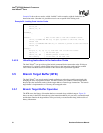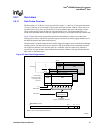
Hardware Reference Manual 99
Intel
®
IXP2800 Network Processor
Intel XScale
®
Core
3.6.1.3 Write Buffer and Fill Buffer Overview
The Intel XScale
®
core employs an eight entry write buffer, each entry containing 16 bytes. Stores
to external memory are first placed in the write buffer and subsequently taken out when the bus is
available. The write buffer supports the coalescing of multiple store requests to external memory.
An incoming store may coalesce with any of the eight entries.
The fill buffer holds the external memory request information for a data cache or mini-data cache
fill or non-cacheable read request. Up to four 32-byte read request operations can be outstanding in
the fill buffer before the Intel XScale
®
core needs to stall.
The fill buffer has been augmented with a four-entry pend buffer that captures data memory
requests to outstanding fill operations. Each entry in the pend buffer contains enough data storage
to hold one 32-bit word, specifically for store operations. Cacheable load or store operations that
hit an entry in the fill buffer get placed in the pend buffer and are completed when the associated
fill completes. Any entry in the pend buffer can be pended against any of the entries in the fill
buffer; multiple entries in the pend buffer can be pended against a single entry in the fill buffer.
Pended operations complete in program order.
3.6.2 Data Cache and Mini-Data Cache Operation
The following discussions refer to the data cache and mini-data cache as one cache (data/mini-
data) since their behavior is the same when accessed.
3.6.2.1 Operation when Caching is Enabled
When the data/mini-data cache is enabled for an access, the data/mini-data cache compares the
address of the request against the addresses of data that it is currently holding. If the line containing
the address of the request is resident in the cache, the access “hits’ the cache. For a load operation
the cache returns the requested data to the destination register and for a store operation the data is
stored into the cache. The data associated with the store may also be written to external memory if
write-through caching is specified for that area of memory. If the cache does not contain the
requested data, the access ‘misses’ the cache, and the sequence of events that follows depends on
the configuration of the cache, the configuration of the MMU and the page attributes.
3.6.2.2 Operation when Data Caching is Disabled
The data/mini-data cache is still accessed even though it is disabled. If a load hits the cache it will
return the requested data to the destination register. If a store hits the cache, the data is written into
the cache. Any access that misses the cache will not allocate a line in the cache when it’s disabled,
even if the MMU is enabled and the memory region’s cacheability attribute is set.


















